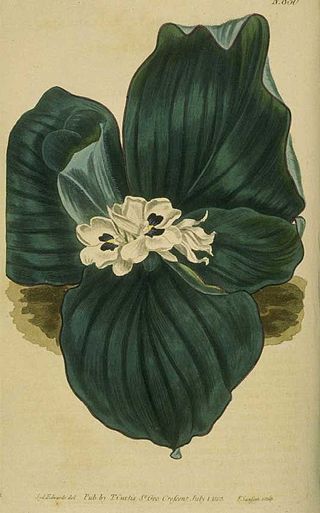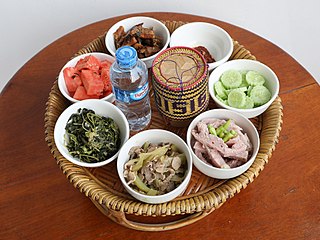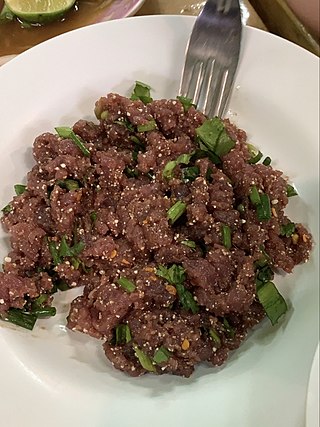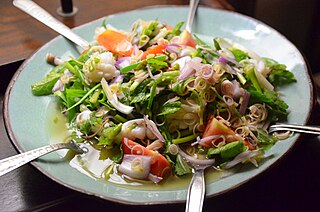Yum sen lon, also known as a yum salad, is a Laotian salad. It is served with watercress, lettuce, tomato, and boiled egg, with mayonnaise and peanuts. [1]

Dill is an annual herb in the celery family Apiaceae. It is native to North Africa, Iran, and the Arabian Peninsula; it is grown widely in Eurasia, where its leaves and seeds are used as a herb or spice for flavouring food.

KFC Corporation, doing business as KFC, is an American fast food restaurant chain that specializes in fried chicken. Headquartered in Louisville, Kentucky, it is the world's second-largest restaurant chain after McDonald's, with over 30,000 locations globally in 150 countries as of April 2024. The chain is a subsidiary of Yum! Brands, a restaurant company that also owns the Pizza Hut and Taco Bell chains.

Long John Silver's, formerly known as Long John Silver's Seafood Shoppes and sometimes abbreviated as LJS, is an American chain of fast-food restaurants that specializes in seafood. The brand's name is derived from the character of the same name from Robert Louis Stevenson's novel Treasure Island.

Galangal is a common name for several tropical rhizomatous spices.

Lao cuisine or Laotian cuisine is the national cuisine of Laos.

Laab / Larb is a type of Lao meat salad that is the national dish of Laos, along with green papaya salad and sticky rice. Laab in the Lao language is a noun that refers to meat or other flesh that has been finely chopped and pounded. It is also considered a food of good luck in both Laos and Thailand because it has homonyms that mean 'lucky' in both languages, derived from लाभ in Sanskrit. Laab is of Lao origin, but is also eaten in other regions, most prominently the neighboring former Lan Xang territory, or modern day Laos and the northeastern and northern areas of Thailand, Isan and Lanna where the Lao have extended their influence. Other local variants of laab also feature in the cuisines of the Tai peoples of Shan State, Burma, and Yunnan Province, China.

Fry sauce is a condiment often served with French fries or tostones in many places in the world. It is usually a combination of one part tomato ketchup and two parts mayonnaise. Historically, the Argentinian salsa golf is most likely the first ketchup and mayonnaise sauce, having been invented in the 1920s by Luis Leloir.

Green papaya salad is a spicy salad made from shredded unripe papaya. It is generally believed to have been created by the Lao people and is considered one of the national dishes of Laos. Green papaya salad is also popular in neighbouring Thailand's Isan region, whose population is mainly composed of ethnic Lao and from where it spread to the rest of Thailand. Green papaya salad has also spread to the rest of the continental Southeast Asia, as well as Xishuangbanna (China).

Kai yang or gai yang, also known as kai ping or gai ping, or pīng kai, is a Lao dish originating in Laos, but it is now commonly eaten throughout the whole of Thailand. The dish is a standard staple of street markets and readily available at all times. Being a typical Laotian dish, it is often paired with green papaya salad and sticky rice (Thai/Isan: ข้าวเหนียว, pronounced[kʰâːwnǐa̯w]; Lao: ເຂົ້າໜຽວ or eaten with sticky rice in bamboo. It is also eaten with raw vegetables, and often dipped in spicy sauces such as Laotian jaew bong.

The nearly thirty Palaungic or Palaung–Wa languages form a branch of the Austroasiatic languages.

Lemon basil, hoary basil, Thai lemon basil, or Lao basil, is a hybrid between basil and American basil. The herb is grown primarily in northeastern Africa and southern Asia for its fragrant lemon scent, and is used in cooking.

Nam tok is either a soup or a meat salad from Southeast Asia. In the Lao and Thai language, the phrase means waterfall. The meat salad in Lao cuisine is a sliced beef steak instead of minced meat version of larb, Laos' national dish.

Naem khao, also known as yam naem is a very popular Lao appetizer salad originating from Tha Deua, a small port village, in Vientiane, Laos.

Koi is a "salad" dish of the Lao people living in modern-day Laos and Isan, Thailand, consisting of raw meat denatured by acidity, usually from lime juice. Common varieties include koi kung, with shrimp as the main ingredient, and koi paa /koi pla, which consists of minced or finely chopped raw fish in spicy salad dressing.
Tai Loi, also known as Mong Lue, refers to various Palaungic languages spoken mainly in Burma, with a few hundred in Laos and some also in China. Hall (2017) reports that Tai Loi is a cover term meaning 'mountain Tai' in Shan, and refers to various Angkuic, Waic, and Western Palaungic languages rather than a single language or branch. The Shan exonym Tai Loi can refer to:

Ant eggs refer to both the eggs and pupae of weaver ants eaten in several countries across Southeast Asia, especially Laos and Northeastern Thailand (Isan). They are high in protein and enjoyed for their sourness and pop when eaten along with soups, omelets, and salads.

Salads that are internationally known as Thai salads with a few exceptions fall into four main preparation methods. In Thai cuisine these are called yam, tam, lap and phla. A few other dishes can also be regarded as being a salad.
Yam khanom chin is a spicy and sour Thai dish made with khanom chin; thin rice noodles that and are most commonly eaten as part of the cuisines of East and Southeast Asia. Yam khanom chin consists of khanom chin, lime juice, ground chili, fish sauce, and sugar; fermented fish sauce may also be added. It speeds up metabolism as well as helping the excretory system. It is also a low-calorie food, with 220 calories per dish.